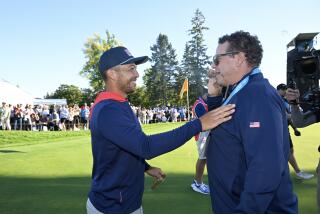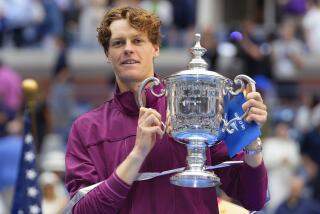Homeboys Claim Open as Their Turf
- Share via
NEW YORK — First came talk of the Swedish Slam. Then it was the Awesome Aussies.
As the U.S. Open enters its late stages, it is, appropriately enough, the resurgent Americans who are stealing the attention.
Five Americans made the final 12 in men’s singles, led by 36-year-old Jimmy Connors and two teen-agers, 18-year-old Andre Agassi and 16-year-old Michael Chang. With Connors’ 6-1, 6-2, 6-0 rout of Jorge Lozano Tuesday, at least one American is guaranteed a spot in the semifinals.
While Connors seeks his sixth Open title and Agassi tries to win his seventh championship this year and first Grand Slam crown, Aaron Krickstein is staging a comeback. And Derrick Rostagno sneaked into the quarterfinals virtually unnoticed, although he upset another American, No. 9 Tim Mayotte, in the third round.
On Tuesday, Rostagno beat Ronald Agenor of Haiti 6-2, 3-6, 6-1, 6-3 to make the final eight.
But the most intriguing American is Chang, the youngest player on the tour. He has surged from 163d to 48th on the computer and is certain to go higher after the Open.
“I wanted to come here and do better than I did last year,” said Chang, a resident of Placentia. Last year, he became the youngest man to win an Open match when, at 15, he beat Paul McNamee in the first round.
“I never look ahead beyond an opponent, so I really didn’t want to think about how far I could get or who I might play,” Chang said. “But I didn’t want to go out early.”
Agassi hasn’t gone out early in a tournament since April, when he lost in the second round at Seoul. He is the hottest player on the circuit, having moved from 25th to fourth in the rankings, and had won 21 straight matches before meeting Chang Tuesday night. Agassi is the youngest American ever to get that high in the rankings.
“You hear players like (top-ranked Ivan) Lendl talking about how the only tournaments that really matter are the slams,” Agassi said. “I think every tournament is important.
“It’s important to get the experience on the tour and to play a lot of matches to see how much you can do and how much more you need to do. Playing so much is why I’ve gotten where I have.”
Krickstein had gotten up to seventh in the world in 1985, but a knee injury and an auto accident stymied his career. He had dropped to 61st in the world entering 1988.
With a more aggressive style that includes coming to the net, Krickstein, once a devout baseliner, has staged an impressive comeback. He’s been in three semifinals this year and moved to 20th in the rankings.
“I feel that my game is better than it was when I was No. 7,” Krickstein, 21, said. “My ranking is going up and I just have to see how far I can go. . . . “
Krickstein’s victory over No. 3 Stefan Edberg in the fourth round might be the biggest boost to his career.
“It’s a great win for me, but it’s something that should get my confidence going knowing that I can play with the best players,” he said. “Whenever you have big ones in big tournaments, you remember those and you want to keep doing well.
“When you are losing, you kind of get used to losing. That’s why Agassi has done so well. He wins so much and he wins all the time. He doesn’t even know what losing is.”
Rostagno sort of got lost in the headline-grabbing of the other kids. A 22-year-old former Stanford All-American, Rostagno has gone from No. 60 to No. 52 in the rankings, a modest gain compared to his peers.
But he nearly beat Connors at Wimbledon, losing in five sets, has made two semifinals, and easily swept past Mayotte.
“I think it’s coming all together this year,” he said. “I’m trying to be solid both mentally and physically. The mental attitude probably separates the top players. Everybody has the game.”
Connors has had the game for nearly two decades. He’s also had the mental toughness and, most of the time, the conditioning.
What does he think of the youth wave?
“Maybe the talent has been out there all along,” he said. “And now it’s just showing.
“The first opportunity I had was when I was 17,” Connors recalled. “I played pre-qualifying and qualifying to get into a tournament in L.A. I played Roy Emerson in the first round. I was lucky I made it through that match with some lucky shots.
“Now they come out on the road when they are 15 or 16. I was 19 and it’s a difference. Now, they are out there going after the money.
“Back in my time, you went out there to be the best player--the best in the U.S., the best in Canada or maybe the best in the world.
“Now, the players just see the money. They’re kicked out there and they make a half million, but they can’t lift their arm after a year. It’s a different breed of animal.”
More to Read
Go beyond the scoreboard
Get the latest on L.A.'s teams in the daily Sports Report newsletter.
You may occasionally receive promotional content from the Los Angeles Times.










